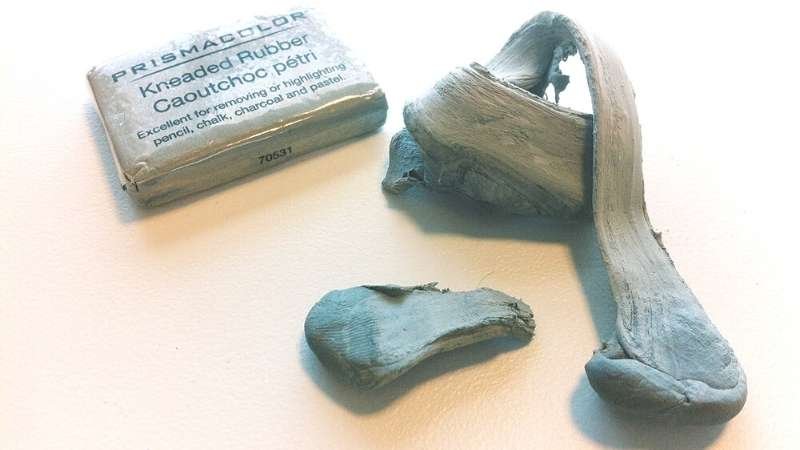Most of us remember the bright yellow pencil we started with to make marks and learn writing and arithmetic skills. It had the handy little eraser on one end and my favorite part was being able to sharpen it. Sticking the pencil into the sleek chrome pencil sharper with the crank on the other end and winding it around and around, periodically checking its sharpness is a fond memory.
This TED video on YouTube "Why the pencil is perfect" might ignite the artist in you and perhaps bring new light to the ordinary pencil.
Rather than a permanent mark like a pen the sweet little pencil allows mistakes and corrections to occur. The eraser on some pencils is such a weird color like -hmmm pink, flesh color, puce (what's that color?) and sometimes it just makes the erasure worse leaving behind impossible to remove graphite streaks. So pick up a kneader eraser when your creating you drawings to remove any errors, works much better and you will like the silly putty feel of it and kneading process.
I find the octagonal shape of the pencil to be a plus and a minus. The many facets of the octagon help hold the pencil firmly but lets not grip so hard we create calluses so loosen the mind and loosen the grip.
Ever wonder which pencil is best for your needs? Lets examine a few options starting with the hardness of the graphite inside the pencil.
Historically, pencil manufacturers use a numeric score and a letter on their pencils. The number indicates the hardness of the graphite (how much clay is added) and the higher the number the harder the core which equates to a lighter mark.
The second graphite grading scale is known as the HB scale (H, HB, B 2B etc). Most pencil manufacturers outside of the U.S. use this scale, using the letter “H” to indicate a hard pencil. Likewise, a pencil maker might use the letter “B” to designate the blackness of the pencil’s mark, indicating a softer lead. The letter “F” is also used to indicate that the pencil sharpens to a fine point.
Source: Pencils.com
GRAPHITE SCALE COMPARISONS
Generally, an HB grade about the middle of the scale is considered to be equivalent to a #2 pencil using the U.S. numbering system.
I like to use either a Tombow 4H or the Staedtler/Mars-lumograph drawing pencil 3H
In reality however, there is no specific industry standard for the darkness of the mark to be left within the HB or any other hardness grade scale. Thus, a #2 or HB pencil from one brand will not necessarily leave the same mark as a #2 or HB pencil from another brand. Most pencil manufacturers set their own internal standards for graphite hardness grades and overall quality of the core, some differences are regional. In Japan, consumers tend to prefer softer darker leads; so an HB lead produced in Japan is generally softer and darker than an HB from European producers.
Because H pencils are harder, they will leave a lighter graphite trail on the paper.
On the other hand, B pencils leave a darker trail, because they are softer.
F stands for Fine. It is a type of pencil that’s easy to keep sharp, but also one that’s hard. It’s rather difficult to draw with this type of pencil if you’re a beginner (but also good for tracing or pre water color painting.
HB pencils are right in the middle of the scale. They are also considered to be hard for drawing.
The number that comes with the letter is also an important hint that will tell you a lot about the darkness/lightness of a pencil. For example, a pencil that has more Hs is harder compared to one with less Hs, which also means it’s lighter. In other words, the 9H pencil is the hardest one out there, but also the one that leaves the lightest trail.
Consequently, if a pencil has more Bs, it is softer, and will, therefore, leave a darker trail. That means that a 7B pencil will leave a darker mark compared to a 3B one.
Staedtler/Mars - Lumograph Drawing Pencil - 3H - good for drawing out your water color painting.
The best type of pencil to use for watercolor painting is a sketching pencil with hard lead, generally between 9H and 4H (according to the figure above) , or to avoid sketching at all. If you choose a pencil that is too soft, it will be hard to erase before water coloring. If you choose a pencil that is too hard, it could damage your paper.
Finding what works best for your own artistic and writing needs is generally a matter of personal preference and experimentation with different brands of pencils.
At first, you’re eager to draw and will use just about any piece of paper you can get your hands on to do so. However, you should know that the texture of the paper you use has a huge impact on the final result. Certain effects are easier to achieve when the paper has the right texture. The paper’s texture is often known as the tooth of the paper. A rougher tooth is more visible, so the paper will best catch the graphite from your pencils. If the texture of the paper is smooth, your pencil will have less grip.



